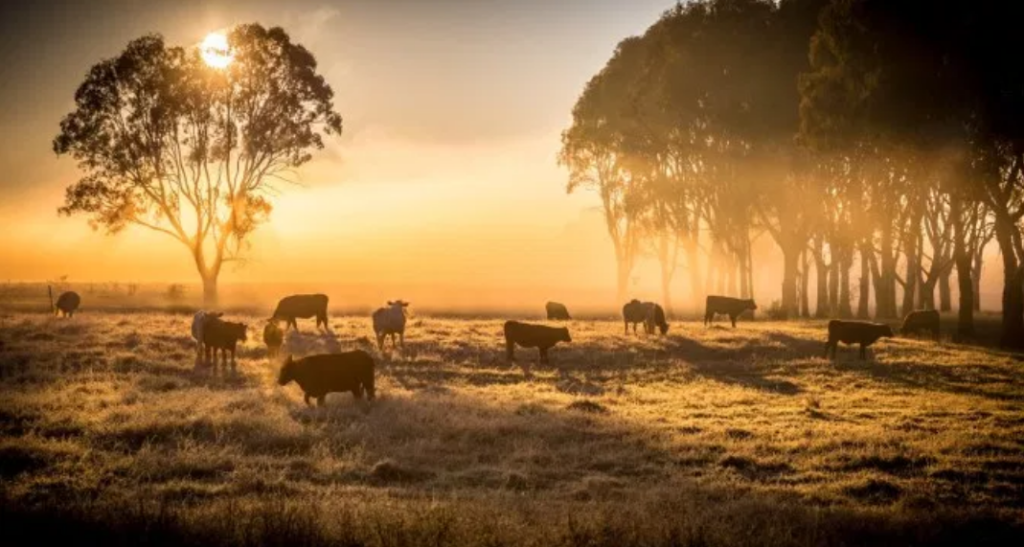
From AgFunder News:
While earning his undergraduate degree, Dr. Richard Teague knew that the grassland and cropping management being taught wasn’t truly sustainable.
“Agricultural land is generally being managed in a manner that is degrading the land resource. In particular, the soil function and ecosystem biodiversity that we need working properly to provide the ecosystem services that we depend on—we have to look at it in a different way,” he tells AFN.
Now a grazing systems ecologist and professor at Texas A&M AgriLife Research, Teague grew up in Zimbabwe. His father had an ecological education, so Teague has always approached agricultural research through this lens. After obtaining a PhD in the Department of Botany and Microbiology at the University of Witwatersrand, Johannesburg, South Africa, he was recruited to the United States in 1991. Then, looking to speak to farmers who had shown the highest soil carbon levels while doing well in their businesses, he contacted the USDA-Natural Resources Conservation Service (NRCS) in Texas.
This connected Teague with farmers using adaptive multi-paddock (AMP) grazing farmers—all were improving soil health. While he already knew that better soil carbon levels meant better water infiltration rate and better soil fertility, Teague was inspired to collect data in comparison to their neighbors’ conventional management.
These farmers were using regenerative farming practices, which use cover crops, no-till, crop diversity, little or no chemical fertilizers and pesticides, and livestock integration to promote healthier ecosystems by rebuilding soil organic matter. The regenerative agriculture movement has been gaining traction amongst farmers across the world. Starting with a small number of people at the grassroots level, it’s recently been at the heart of many corporate sustainability initiatives, as well. Teague is working to quantify the impact of AMP grazing management on soil health and environmental health—though he is careful to not extrapolate the data from bite-sized, snippets to something headline-worthy.
“Most academics deny that regenerative grazing and cropping management works at all, and yet there’s a whole network of people around the world that we’re connected with who have increased a minimum of two-to-three-fold in production of their land and profitability compared to when they started,” he explains.
Last week, Indigo Agriculture, the Boston-based agtech startup, announced an ambitious goal to sequester one trillion tons of carbon through regenerative farming practices and the launch of significant research with the Soil Health Institute to better understand how these practices positively impact the farm and the environment.
As we build out our coverage of regenerative agriculture, we caught up with Teague to find out more about his work.
What is AMP grazing management, and how does it work?
Dr. Richard Teague: People normally stock cattle in large paddocks where they graze without recovery through the year, and they think that by stocking lightly they’re going to have light use on the land. But that’s not what happens. Animals invariably pick the spots that they want to graze, and they graze and graze and graze them, under-grazing the rest of the property. The overgrazed plants’ rooting depth is diminished, and their productivity is diminished. Then, when those grasses are not producing anymore within a season, the cattle switch to the other grasses, which of course have grown tall and are very low-quality. So, reducing the stocking numbers alone hasn’t worked and is only a partial solution.
Those who are managing using AMP grazing subdivide existing paddocks with electric fence—so they can do it cheaply—grazing for one to three days maximum and giving adequate recovery. That recovery time will depend on where you are: in the growing season here in the Dallas area, you need to shoot to rest for a good 60 days, and in the non-growing season, 90 days, because the plants are growing more slowly at that point. In dry areas, recovery periods need to be about double these figures.
We’ve seen that the folks who have been using AMP grazing management effectively in north Texas have much more carbon in the ground relative where they started, and relative to what carbon levels their neighbors have, with either heavy or light continuous stocking of cattle. It was quite interesting when we initially visited these farms with the NRCS technicians, you could walk onto one of the AMP farms and there would be much more grass even though they had twice as many animals as their neighbors. That is because they were producing more grass by managing in a way that allowed recovery of the plant leaves and roots after grazing, and this benefited the soil infiltration rates and fertility. When we measured it, there were huge amounts of extra carbon in the ground where they had AMP grazed.
That’s where my research began. We’ve now spread through North America, and we’re currently doing very detailed across-the-fence comparisons among grazing farmers using current management practices and regenerative AMP grazing farmers in Kentucky, Tennessee, Alabama, and Mississippi. We’re getting very similar results to those we obtained in Texas.
For those practicing conventional management right now, what are the blockers to converting to these regenerative practices?
Teague: The biggest challenge is basically humans not liking to change. However, purchased inputs have become very expensive, reducing farm margins. This presents significant teaching opportunities as regenerative farming requires much lower inputs and has the prospect of improving soil health to improve margins.
Also, experienced and successful farmers like Gabe Brown are setting an excellent example that is helping folks transition to regenerative farming practices. Gabe has just written a book for farmers (Dirt to Soil, One Family’s Journey into Regenerative Agriculture). He was failing because he was experiencing consecutive droughts in a very low-rainfall area in the northern Great Plains. And many of his pals were, too; they were farming conventionally with fertilizers and pesticides and plowing every year. With the droughts, they were unable to secure loans to continue farming with expensive conventional inputs.
They had to find another way of doing things, which was the biological way. Fortunately, the NRCS helped them. They then managed to stay in business, moving from total chemical and pesticide dependence to minimizing or eliminating chemicals and pesticides.
There’s a whole lot of things you’ve got to learn to be able to do that – principally, how to transition and how to cash flow it. And that’s where a person who’s done successfully before can provide essential help – folk like Gabe Brown, and the regenerative networks we communicate through. You learn best from the guys who have done it. Most scientists have done only small plot experiments here and there, and they don’t know how to manage complex, multifaceted farm businesses because they don’t work on all the things involved with a whole business, especially using biological regenerative methods. They don’t have to make a living at it. We do all our research with the regenerative farmers because they know how to put it together into a successful business plan.
Do farmers transitioning to regenerative practices need to take a financial hit?
Teague: What the successful folk have done is start off small. They start off on a portion of their land to learn how to do it. They wouldn’t go from one year having the quantity of chemical and pesticides they have been using to nothing the next year. An example that has succeeded is cutting the applications in half the first year, again the next year, and then applying nothing the third year.
Gabe Brown managed the transition by stopping tillage and using crop rotations and cover crops. Stopping tillage reduced the soil carbon loss, and the cover crops were a low-cost means of improving soil infiltration and fertility, reducing pesticide damage and producing fodder for livestock. But they learned from the NRCS that you need a mixture of cover crops. The soil microbial synergisms that result from putting multiple species in their cover crops mixes improve the soil carbon and soil fertility much more than just a single or two to three species did.
Brown built his whole success on those two things: no-till and cover crops. He later learned that using the AMP grazing we research (graze for short periods and allow recovery, in conjunction with no-till tools and the use of mixed-species cover crops) enhanced fertility even more.
We’ve known for a long time that animals managed properly in permanent pasture grazing increases the soil carbon better than anything. These successful regenerative farmers have been able to teach others how to transition just one step at a time. And there’s a network with Gabe, Ray Archuleta and Dr. Allen Williams with the Soil Health Academy, and other folks who are doing an excellent job around the country educating people on how to actually transition from one to the other and cash flow it, while achieving soil health and increasing profit outcomes.
Can you describe how you’ve seen these practices growing in different regions?
Dr. Teague: Let me start with the latest research we’ve done in Kentucky, Tennessee, Alabama (2 sites), and Mississippi. In five years, the AMP folks there have increased their carbon hugely. There was already published work from Georgia, before we started our research, that showed in just six years an increased amount of soil carbon of eight tons per hectare per year by moving from cropped land to permanent AMP grazed pastures managed correctly. The figures we’ve obtained are similar. We haven’t got the full figures yet, because we’re still analyzing the soil carbon through the full rooting depth.
But at the other end of the scale, one of the best dry country managers we’ve got is Alejandro Carrillo in Northern Mexico. He farms in an area with an average of six inches of rainfall per year. He has reclaimed what was just bare ground on his ranch (in common with the whole region) to having as much grass as many ranchers in areas of Texas having 25 inches of rainfall. His farm stands out in stark relief to the neighbors’ ranches, which are still like his ranch was before he improved his grazing management.
This is by making sure there’s always vegetation on the ground and that it has time to recover after every grazing, that results in more water getting on the ground and deeper grass roots to survive drought periods. You can be in a wet area and still have bare ground with poor grazing management, resulting in not getting as much rain into the soil as you think you are. So, it all depends on improving soil biology. That’s the root of success.
There are claims that transitioning 10% to 20% of agricultural production to regenerative practices could sequester enough carbon dioxide to reverse climate change. Given your research in the field, do you agree?
Teague: In science, we have to try and understand what’s going on. No single experiment solves all the problems. But all the data we’ve collected suggests that the more people that manage their soil better, either in grazing or cropping systems, the more carbon will be sequestered in the ground. And that is likely to be a really significant factor for improving soil health and all the positive benefits that would result in.
Now, I have studiously stayed away from trying to make global predictions from these figures, because outcomes in different places in the world are so variable. But that doesn’t stop many people—many of whom I respect—from using my data and other similar data to make such extrapolations. And their calculations—pencil-on-the-back-of-a-postage-stamp calculations—suggest that increases in soil carbon would be a significant factor in putting more water in the soil, improving watershed function and water quality, reducing flooding and soil erosion, and increasing plant productivity.
We are concentrating on understanding the biology and how to manage for more desirable outcomes in agricultural landscapes. We need to use such knowledge of biology so that, first, the farmers are rewarded directly for farming better with improved food quality and profits. These other advantages accrue to increased diversity of beneficial fungi, microbes, plants, insects such as pollinators, and reducing all the pesticide and nutrient runoff-related problems we’ve got with the Mississippi catchment and the dead zone in the Gulf of Mexico.
All the regenerative farmers that we’ve been working with, like Gabe Brown, have facilitated these positive outcomes. They’ve reduced costs and increased productivity, so their profitability has gone up. But the profitability is not by buying stuff and putting it in the soil, it’s by looking after the biology and relying on improved profits that accrue from the soil functioning better and working for them better by not using practices that degrade soil and ecosystem function.
These days, meat production gets a bad reputation for the industry’s greenhouse gas emissions. Do you think that is accurately represented?
Teague: The problem with a lot of research now is that it’s part of the Hollywood syndrome. They have agenda-driven research that wants to show certain things. Much research does not aim at developing an understanding of the positives and negatives of different management options so the best outcomes can be achieved on multiple fronts. Rather, they do so to push self-serving goals without considering the unintended outcomes of different options.
Our field research shows that even simple grazing, when you look after the grass reasonably well, will put more carbon in the ground than the emissions emitted by the cattle grazing—up to about three or four times as much. In the more sophisticated grazing systems we have been studying, there is an order of eight times as much carbon dioxide equivalents being sequestered into the soil as is being emitted by the cattle.
This is if the cattle are on perennial grass. As soon as you take the cattle off permanent grass and feed them corn, their net emissions are increased substantially. Industrial cropping methods have a large carbon footprint due to the amount of fossil fuels used in cropping and the very high soil erosion that occurs with such methods of production. When you feed cattle corn, they inherit the corn’s very large carbon footprint. And that’s one of the reasons why grass-fed and grass-finished beef has caught people’s attention. Being fed only on perennial grass without fossil energy-based inputs creates a strong carbon negative production system.
Consequently, on perennial pastures, these practices reduce soil erosion because the ground is covered (so the ground can hold more carbon). Carbon emissions from either high input cropping agriculture or from ruminants is potentially high, and the permanent pastures with low inputs are the best means of reducing it. We still have to have cropping, but you can grow cropping, as folk like Gabe Brown and the Rodale Institute has shown, in a manner that has no tillage, uses cover crops, and has a very negative carbon footprint. If you’ve got a strong carbon negative footprint from cropping using regenerative organic methods, as well as from a grazing component, then you’ve likely created a carbon negative, or close to negative, agriculture.
Those two words, regenerative organic, are very, very important. Many people just think, “Oh, organic is good.” It has good elements, but also too many bad elements in it the way a lot of people practice it. Adding the regenerative portion has removed the tillage and use of pesticides (or at least minimized them) so that you don’t increase the carbon footprint. If you farm regenerative organic, you will have a strong carbon negative footprint.
What can and should consumers do to tackle these issues?
Dr. Teague: People need to be educated as to what actually constitutes something negative compared to something positive. If they can move to regenerative agriculture, and if an informed public can buy products from regenerative ag, then we will start reducing the problems that industrial agriculture is currently producing.
It’s difficult to change farmers’ minds. Their whole business is put at risk every single year, so they’re very risk-averse. If we can develop markets where there’s a strong demand for products from regenerative ag, that will give them the message that we need to head in that direction.
And then, of course, a lot of work still has to be done teaching farmers how to do that. That’s where Gabe Brown, Ray Archuleta, and Allen Williams, with the Soil Health Academy, are already playing a great role in informing both farmers and the general public about the benefits of moving to regenerative agriculture with all its benefits.
What are some resources to help farmers make this transition?
Dr. Teague: We regularly participate in soil health workshops throughout Texas with NRCS. Connecting with the local NRCS folks for their soil health workshops and field days and Soil Health conferences throughout U.S. is one of the best ways to learn. They also have services to help with farm planning in different regions. Every region is different, so you’ve got to get the information from the local guys as to what works in that area. They can tell you what cover crop mixes you need to use on what soils for your area.
The only downfall of NRCS is they don’t deal with economics. You have to get the economic advantages from our regenerative farmer networks and other researchers working with them. There are a number of USDA-ARS researchers who are well-informed and have done good research in this area.
Everyone should watch the “Carbon Cowboys” films. The guy who’s heading up our particular research group is an exceptional filmmaker, Peter Byck. He’s got about 15 of them, about 15 minutes each. They’re short, because we know people respond more positively to short education videos.


